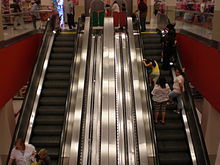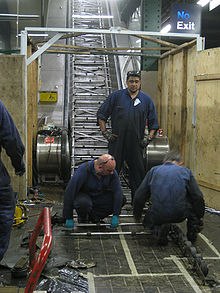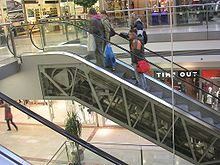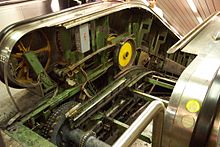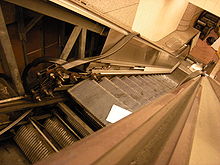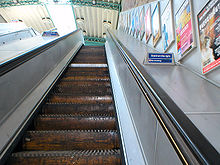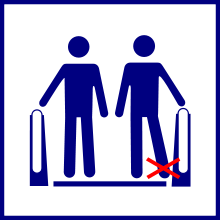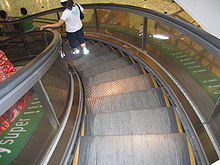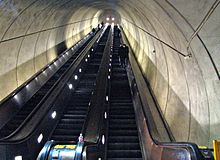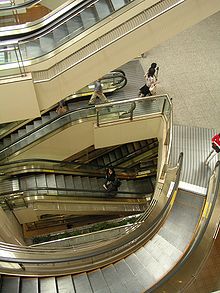- Escalator
-
For the album by Sam Gopal, see Escalator (album).
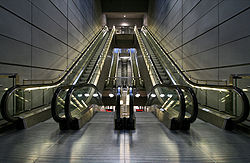 Escalators in a Copenhagen Metro station, Denmark, 2007
Escalators in a Copenhagen Metro station, Denmark, 2007 Escalator in action, 2011
Escalator in action, 2011
An escalator is a moving staircase – a conveyor transport device for carrying people between floors of a building. The device consists of a motor-driven chain of individual, linked steps that move up or down on tracks, allowing the step treads to remain horizontal.
Escalators are used around the world to move pedestrian traffic in places where elevators would be impractical. Principal areas of usage include department stores, shopping malls, airports, transit systems, convention centers, hotels, and public buildings.
The benefits of escalators are many. They have the capacity to move large numbers of people, and they can be placed in the same physical space as one might install a staircase. They have no waiting interval (except during very heavy traffic), they can be used to guide people toward main exits or special exhibits, and they may be weatherproofed for outdoor use.
Design, components, and operation
Operation and layout
Escalators, like moving walkways, are powered by constant-speed alternating current motors[citation needed] and move at approximately 1–2 feet (0.30–0.61 m) per second. The typical angle of inclination of an escalator to the horizontal floor level is 30 degrees with a standard rise up to about 60 feet (18 m). Modern escalators have single-piece aluminum or steel steps that move on a system of tracks in a continuous loop.
Escalators have three typical configuration options: parallel (up and down escalators "side by side or separated by a distance", seen often in metro stations and multilevel motion picture theaters), crisscross (minimizes structural space requirements by "stacking" escalators that go in one direction, frequently used in department stores or shopping centers), and multiple parallel (two or more escalators together that travel in one direction next to one or two escalators in the same bank that travel in the other direction).[1]
Escalators are required to have moving handrails that keep pace with the movement of the steps. The direction of movement (up or down) can be permanently the same, or be controlled by personnel according to the time of day, or automatically be controlled by whoever arrives first, whether at the bottom or at the top (the system is programmed so that the direction is not reversed while a passenger is on the escalator).
Design and layout considerations
A number of factors affect escalator design, including physical requirements, location, traffic patterns, safety considerations, and aesthetic preferences. Foremost, physical factors like the vertical and horizontal distance to be spanned must be considered. These factors will determine the pitch of the escalator and its actual length. The ability of the building infrastructure to support the heavy components is also a critical physical concern. Location is important because escalators should be situated where they can be easily seen by the general public. In department stores, customers should be able to view the merchandise easily. Furthermore, up and down escalator traffic should be physically separated and should not lead into confined spaces.
Traffic patterns must also be anticipated in escalator design. In some buildings, the objective is simply to move people from one floor to another, but in others there may be a more specific requirement, such as funneling visitors towards a main exit or exhibit. The number of passengers is important because escalators are designed to carry a certain maximum number of people. For example, a single-width escalator traveling at about 1.5 feet (0.46 m) per second can move an estimated 170 persons per five-minute period. The carrying capacity of an escalator system must match the expected peak traffic demand, presuming that passengers ride single file. This is crucial for applications in which there are sudden increases in the number of riders. For example, escalators at stations must be designed to cater for the peak traffic flow discharged from a train, without causing excessive bunching at the escalator entrance.
In this regard, escalators help in controlling traffic flow of people. For example, an escalator to an exit effectively discourages most people from using it as an entrance, and may reduce security concerns. Similarly, escalators often are used as the exit of airport security checkpoints. Such an egress point would generally be staffed to prevent its use as an entrance, as well.
It is preferred that staircases be located adjacent to the escalator if the escalator is the primary means of transport between floors. It may also be necessary to provide an elevator lift adjacent to an escalator for wheelchairs and disabled persons. Finally, consideration should be given to the aesthetics of the escalator. The architects and designers can choose from a wide range of styles and colors for the handrails and balustrades.
Model sizes and other specifications
Escalator step widths and energy usage Size Width (between balustrade panels) Single-step capacity Applications Energy consumption Very small 400 mm (16 in) One passenger, with feet together A rare historic design found mostly in older department stores 3.7 kW (5.0 hp) Small 600 mm (24 in) One passenger Low-volume sites, uppermost levels of department stores, when space is limited 3.7 kW (5.0 hp) Medium 800 mm (31 in) One passenger + one package or one piece of luggage Shopping malls, department stores, smaller airports 7.5 kW (10.1 hp) Large 1,000 mm (39 in) Two passengers – one may walk past another Mainstay of metro systems, larger airports, train stations, some retail usage 7.5 kW (10.1 hp) Components
- Landing platforms
- These two platforms house the curved sections of the tracks, as well as the gears and motors that drive the stairs. The top platform contains the motor assembly and the main drive gear, while the bottom holds the step return idler sprockets. These sections also anchor the ends of the escalator truss. In addition, the platforms contain a floor plate and a combplate. The floor plate provides a place for the passengers to stand before they step onto the moving stairs. This plate is flush with the finished floor and is either hinged or removable to allow easy access to the machinery below. The combplate is the piece between the stationary floor plate and the moving step. It is so named because its edge has a series of cleats that resemble the teeth of a comb. These teeth mesh with matching cleats on the edges of the steps. This design is necessary to minimize the gap between the stair and the landing, which helps prevent objects from getting caught in the gap.
- Truss
- The truss is a hollow metal structure that bridges the lower and upper landings. It is composed of two side sections joined together with cross braces across the bottom and just below the top. The ends of the truss are attached to the top and bottom landing platforms via steel or concrete supports. The truss carries all the straight track sections connecting the upper and lower sections.
- Tracks
- The track system is built into the truss to guide the step chain, which continuously pulls the steps from the bottom platform and back to the top in an endless loop. There are actually two tracks: one for the front wheels of the steps (called the step-wheel track) and one for the back wheels of the steps (called the trailer-wheel track). The relative positions of these tracks cause the steps to form a staircase as they move out from under the combplate. Along the straight section of the truss the tracks are at their maximum distance apart. This configuration forces the back of one step to be at a 90-degree angle relative to the step behind it. This right angle bends the steps into a shape resembling a staircase. At the top and bottom of the escalator, the two tracks converge so that the front and back wheels of the steps are almost in a straight line. This causes the stairs to lay in a flat sheetlike arrangement, one after another, so they can easily travel around the bend in the curved section of track. The tracks carry the steps down along the underside of the truss until they reach the bottom landing, where they pass through another curved section of track before exiting the bottom landing. At this point the tracks separate and the steps once again assume a staircase configuration. This cycle is repeated continually as the steps are pulled from bottom to top and back to the bottom again.
- Steps
- The steps themselves are solid, one piece, die-cast aluminum or steel. Yellow demarcation lines may be added to clearly indicate their edges. In most escalator models manufactured after 1950, both the riser and the tread of each step is cleated (given a ribbed appearance) with comblike protrusions that mesh with the combplates on the top and bottom platforms and the succeeding steps in the chain. Seeberger- or "step-type" escalators (see below) featured flat treads and smooth risers; other escalator models have cleated treads and smooth risers. The steps are linked by a continuous metal chain that forms a closed loop. The front and back edges of the steps are each connected to two wheels. The rear wheels are set further apart to fit into the back track and the front wheels have shorter axles to fit into the narrower front track. As described above, the position of the tracks controls the orientation of the steps.
- Handrail
- The handrail provides a convenient handhold for passengers while they are riding the escalator. In an escalator, the handrail is pulled along its track by a chain that is connected to the main drive gear by a series of pulleys. It is constructed of four distinct sections. At the center of the handrail is a "slider", also known as a "glider ply", which is a layer of a cotton or synthetic textile. The purpose of the slider layer is to allow the handrail to move smoothly along its track. The next layer, known as the "tension member", consists of either steel cable or flat steel tape, and provides the handrail with tensile strength and flexibility. On top of tension member are the inner construction components, which are made of chemically treated rubber designed to prevent the layers from separating. Finally, the outer layer—the only part that passengers actually see—is the cover, which is a blend of synthetic polymers and rubber. This cover is designed to resist degradation from environmental conditions, mechanical wear and tear, and human vandalism.
- In the factory, handrails are constructed by feeding rubber through a computer-controlled extrusion machine to produce layers of the required size and type in order to match specific orders. The component layers of fabric, rubber, and steel are shaped by skilled workers before being fed into the presses, where they are fused together.
- In the mid-twentieth century, some handrail designs consisted of a rubber bellows, with rings of smooth metal cladding called "bracelets" placed between each coil. This gave the handrail a rigid yet flexible feel. Additionally, each bellows section was no more than a few feet long, so if part of the handrail was damaged, only the bad segment needed to be replaced. These forms of handrail have largely been replaced with conventional fabric-and-rubber railings.
Safety
Safety is also major concern in escalator design. In India where women wear saris, there are heavy chances of getting the pallu entangled in the escalator. [2] As a result, a special sari guard is built in to most escalators.
There is a risk of feet injuries for children wearing footwear such as Crocs and flip-flops that might get caught in escalator mechanisms.[3][4] This was due to the softness of the shoe's material combined with the smaller size of children's feet.[5]
Fire protection of an escalator floor opening may be provided by adding automatic sprinklers or fireproof shutters to the opening, or by installing the escalator in an enclosed fire-protected hall. To limit the danger of overheating, ventilation for the spaces that contain the motors and gears must be provided.
Accidents and litigation
Accidents
There have been reports of people falling off a moving escalator or getting their shoe stuck in part of the escalator; shoe laces are a hazard when loose. Some accidents are caused by improper or unsafe use such as riding the hand rails (see bullet points below) or by escalator spinning. A few fatal accidents are:
- Eight people died and 30 more were injured on Wednesday, February 17, 1982, when an escalator collapsed on the Moscow Metro. Wrongly set up service brakes were later blamed for the accident.[6]
- 31 people died after a fire, begun in the undercarriage of an MH-type Otis escalator, exploded into the ticketing hall at King's Cross St. Pancras station in 1987.
- On Monday, December 13, 1999, 8-year-old Jyotsna Jethani was killed at New Delhi's international airport. Jethani fell into a gaping hole that resulted from improper maintenance.[7]
- On Saturday, June 15, 2002, Andrea Albright, a 24-year-old J.C. Penney employee in Columbia, Maryland, was critically injured while riding the store's escalator from the first to the second level, and died from her injuries 10 days later. She somehow got her head caught between the escalator rail and a low ceiling. In 2005, her parents sued the property manager, two design firms, and the escalator company for $5 million.[8]
- On Wednesday, July 2, 2003, 30 people were injured when an escalator at Coors Field in Denver malfunctioned, and one victim eventually had to have a leg amputated. The accident is believed to have been caused by a combination of overcrowding and an improperly installed safety switch. [9][10]
- On Friday, December 31, 2004, escalators at the Taipei City Hall Station kept moving commuters onto the overcrowded island platform. A woman whose hair got caught in the escalator received 20 stitches to the scalp.[11]
- Francisco Portillo, a Salvadoran sushi chef, died after being strangled when his sweatshirt got caught in an escalator at the Porter Square MBTA station in Cambridge, Massachusetts on February 21, 2005. He was allegedly drunk at the time.[12]
- On Saturday, September 13, 2008, an 11-year old boy died after falling off an escalator in Lyngdal, Norway.[13] On Monday, April 20, 2009, a teenage boy died after getting very serious skull injuries after falling off an escalator in Falun, Sweden.[14] On Friday, June 26, 2009, a man died after falling off an escalator in Helsingborg, Sweden.[15] All three were riding the handrail.
- On Tuesday, July 6, 2011, a 13-year old boy was killed and dozens of people were injured when they were thrown off an escalator that suddenly changed direction in a busy Beijing subway station. In response to concerns regarding China's safety standards, officials have identified the manufacturers of the escalator as a possible reason for the accident. The escalator was built by Otis and was still in its guarantee period.[16]
Lessons of the King’s Cross fire
The King's Cross fire of 1987 illustrated the demanding nature of escalator upkeep and the devices’ propensity to collect “fluff” when not properly maintained.[17]
In the official inquiry that followed, the Fennell Report, it was determined that the fire started slowly, smoldered virtually undetected for a time, then exploded into the ticketing hall above in a phenomenon known as the “trench effect.” This slow-burning fire, Fennell found, was allegedly kindled by a discarded unextinguished cigarette, which was shown in laboratory tests to be a more powerful ignition source than a lit match.[18] In the escalators’ undercarriage, approximately 8,800 kilograms (19,000 lb) of accumulated detritus acted as a wick to a neglected buildup of interior lubricants; wood veneers, paper and plastic advertisements, solvent-based paint, plywood in the ticket hall, and melamine combustion added to the impact of the calamity.[19]
As a result of the report, older wooden escalators were removed from service in the London Underground (though at least one set remains in operation, at Greenford Station). Additionally, sections of the London Underground that were actually below ground were made nonsmoking; eventually the whole system became a smoke-free zone.
Litigation
In the 1930s, at least one suit was filed against a department store, alleging that its escalators posed an attractive nuisance, responsible for a child’s injury.[20] These cases were almost always dismissed. Moreover, continual updating of escalator safety codes facilitated increased levels of consumer safety as well as a reduction in court cases.
Legislation and escalators
United States
Despite their considerable scope, two Congressional Acts, the Rehabilitation Act of 1973 and the Americans with Disabilities Act of 1990 (ADA), did not directly affect escalators or their public installations. Since Section 504 of the Rehabilitation Act included public transportation systems, for a few years, the United States Department of Transportation considered designs to retrofit existing escalators for wheelchair access. Nonetheless, Foster-Miller Associates’ 1980 plan, Escalator Modification for the Handicapped was ultimately ignored in favor of increased elevator installations in subway systems. Likewise, the ADA provided more accessibility options, but expressly excluded escalators as “accessible means of egress,” advocating neither their removal nor retention in public structures.[21]
Codes and regulation
In the United States and Canada, new escalators must abide by ASME A17.1 standards, and old/historic escalators must conform to the safety guidelines of ASME A17.3. In Europe, the escalator safety code is EN115.
Key safety features developed over time
To enhance passenger safety, newer models of escalators are equipped with one or more of the following safety implementations, as per ASME A17.1 code:
- Antislide devices: Raised circular objects that often stud the escalator balustrade. Sometimes informally called "hockey pucks" due to their appearance, their purpose is to prevent objects (and people) from precipitously sliding down the otherwise smooth metallic surface.
- Combplate impact switches: Stop the escalator if a foreign object gets caught between the steps and the combplate on either end.
- Deflector brush: A long continuous brush made of stiff bristles running up the sides of the escalator just above the step level. This helps deflect garments, shoes, and other items away from the gap between the moving steps and the skirt board.
- Emergency stop button: At each end of the escalator (in some models, also on the balustrade), a large red button can be pressed to stop the device in the event of an emergency. Typically, an alarmed transparent plastic guardplate covers the button; restarting requires turning a key.
- Extended balustrades: Allows riders to grasp the handrail before setting foot on an escalator, to ease customer comfort and stability/equilibrium. (The effect is similar to the flat steps described below.)
- Flat steps: Like a moving walkway, the first two or three steps at either end of the escalator are flat. This gives the passenger extra time to orient him/herself when boarding, and more time to maintain balance when exiting. Longer escalators often have four or more flat steps.
- Handrail inlet switches: Sensors located at the bottom and top of the unit that guard the handrail termini. If something gets caught in these locations, a hard fault is generated in the controller, and the escalator shuts down automatically.
- Handrail speed sensors: These sensors are usually optical, and monitor how fast the handrail moves. If the sensor notices a speed difference between the handrail and the steps, it sounds an alarm, pauses, and then automatically stops the escalator. In these situations, the escalator must be serviced by authorized personnel before returning to an operable state.
- Missing step detectors: Depending on the manufacturer and model, this sensor is either optical or physical. When a missing step is detected, the escalator automatically shuts down.
- Raised step edges: In some models, a difference in tread height is utilized to keep passengers' feet from the skirt board.
- Safety instructions: A sign, typically posted on both escalator newels at the entrance landing platform. In some situations, safety precautions are posted on walls near the escalator, included on freestanding signs, or—as in some models—printed on the riser surface itself.
- Sensor switch: In automatic-start/stop escalators, this sensor automatically engages the escalator motion when a rider is detected on the first step of the entrance landing platform, and stops the escalator when there are no riders on the unit.
- Step demarcation lights: Either fluorescent or LED lights (traditionally green in color) located inside the truss. The illumination between the steps improves the passengers' awareness of the step divisions.
- Step demarcation lines: In order to clearly delineate the edges of each individual step, manufacturers offer steps trimmed in yellow, either painted or with plastic inserts.
Safe riding: official safety foundation guidelines
While some escalator accidents are caused by a mechanical failure, most can be avoided by following some simple safety precautions. The Elevator Escalator Safety Foundation is a major advocate for safe riding in the United States and Canada, sponsors National Elevator Escalator Safety Week each year, and publishes its own suggestions for safe riding. [22]
History
Inventors and manufacturers
Nathan Ames
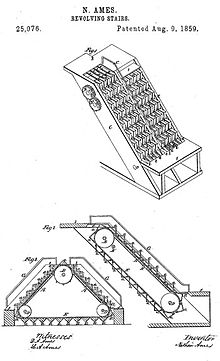 Illustration from U.S. Patent #25,076: Revolving Stairs. Issued August 9, 1859 to Nathan Ames
Illustration from U.S. Patent #25,076: Revolving Stairs. Issued August 9, 1859 to Nathan Ames
Nathan Ames, a patent solicitor from Saugus, Massachusetts, is credited with patenting the first "escalator" in 1859, despite the fact that no working model of his design was ever built. His invention, the "revolving stairs", is largely speculative and the patent specifications indicate that he had no preference for materials or potential use (he noted that steps could be upholstered or made of wood, and suggested that the units might benefit the infirm within a household use), though the mechanization was suggested to run either by manual or hydraulic power.[23]
Leamon Souder
In 1889, Leamon Souder successfully patented the "stairway", an escalator-type device that featured a "series of steps and links jointed to each other". No model was ever built.[24] This was the first of at least four escalator-style patents issued to Souder, including two for spiral designs (U. S. Patent Nos. 723,325 and 792,623).
Jesse Wilford Reno, George A. Wheeler, and Charles Seeberger
In 1892, Jesse W. Reno patented the "Endless Conveyor or Elevator."[25] A few months after Reno's patent was approved, George A. Wheeler patented his ideas for a more recognizable moving staircase, though it was never built.[26] Wheeler’s patents were bought by Charles Seeberger; some features of Wheeler’s designs were incorporated in Seeberger’s prototype built by the Otis Elevator Company in 1899.
Reno, a graduate of Lehigh University, produced the first working escalator (he actually called it the "inclined elevator") and installed it alongside the Old Iron Pier at Coney Island, New York in 1896.[27] This particular device was little more than an inclined belt with cast-iron slats or cleats on the surface for traction, and traveled along a 25° incline. A few months later, the same prototype was used for a monthlong trial period on the Manhattan side of the Brooklyn Bridge. Reno eventually joined forces with Otis Elevator Company, and retired once his patents were purchased outright. Some Reno-type escalators were still being used in the Boston subway until construction for the Big Dig precipitated their removal. The Smithsonian Institution considered re-assembling one of these historic units from 1914 in their collection of Americana, but "logistics and reassembly costs won out over nostalgia", and the project was discarded.[28]
Around May 1895, Charles Seeberger began drawings on a form of escalator similar to those patented by Wheeler in 1892. This device actually consisted of flat, moving stairs, not unlike the escalators of today, except for one important detail: the step surface was smooth, with no comb effect to safely guide the rider's feet off at the ends. Instead, the passenger had to step off sideways. To facilitate this, at the top or bottom of the escalator the steps continued moving horizontally beyond the end of the handrail (like a miniature moving sidewalk) until they disappeared under a triangular "divider" which guided the passenger to either side. Seeberger teamed with Otis Elevator Company in 1899, and together they produced the first commercial escalator which won the first prize at the Paris 1900 Exposition Universelle in France. Also on display at the Exposition were Reno's inclined elevator, a similar model by James M. Dodge and the Link Belt Machinery Co., and two different devices by French manufacturers Hallé and Piat.
Early European manufacturers: Hallé, Hocquardt, and Piat
Piat installed its "stepless" escalator in Harrods Knightsbridge store on Wednesday, November 16, 1898, though the company relinquished its patent rights to the department store. Noted by Bill Lancaster in The Department Store: a Social History, "customers unnerved by the experience were revived by shopmen dispensing free smelling salts and cognac."[29] The Harrods unit was a continuous leather belt made of "224 pieces . . . strongly linked together traveling in an upward direction," and was the first "moving staircase" in England.[30]
Hocquardt received European patent rights for the Fahrtreppe in 1906. After the Exposition, Hallé continued to sell its escalator device in Europe, but was eventually eclipsed in sales by other major manufacturers.
Major competitors and product nomenclature
In the first half of the twentieth century, several manufacturers developed their own escalator products, though they had to market their devices under different names, due to Otis’ hold on the trademark rights to the word “escalator.” New York-based Peelle Company called their models the Motorstair, and Westinghouse called their model an Electric Stairway. The Toledo-based Haughton Elevator company referred to their product as simply Moving Stairs.
Manufacturing mergers and buyouts: the playing field narrows
Kone and Schindler introduced their first escalator models several decades after the Otis Elevator Co., but grew to dominance in the field over time. Today, they, Mitsubishi, and ThyssenKrupp are Otis' primary rivals.
Schindler now stands as the largest maker of escalators and second largest maker of elevators in the world, though their first escalator installation did not occur until 1936.[31] In 1979, the company entered the United States market by purchasing Haughton Elevator; nine years later, Schindler assumed control of the North American escalator/elevator operations of Westinghouse.
Kone expanded internationally by acquisition in the 1970s, buying out Swedish elevator manufacturer Asea-Graham, and purchasing other minor French, German, and Austrian elevator makers before assuming control of Westinghouse’s European elevator business. As the last "big four" manufacturers held on to the escalator market, KONE first acquired Montgomery Elevator Company, then took control of Germany’s Orenstein & Koppel Rolltreppen.
Model development and design types
"Cleat-type" escalators
Jesse Reno's escalators did not resemble modern escalators too closely. Passengers' feet tilted upward at an angle, and the treads consisted of cleated metal (initially) or wood (later models). Reno worked on his own for several years, gaining success with installations from Toronto to Cape Town, South Africa. Similar units of the day by other manufacturers resembled conveyor belts more than moving staircases. For a time, Otis Elevator sold Reno's escalators as their own "cleat-type" escalators.
"Step-type" escalators
Seeberger's model, bought by Otis, clearly became the first "step-type" escalator, so called after its visual likeness to steps on a regular staircase. The company later combined the best aspects of both inventions (guiding slats and flat steps) and in 1921 produced an escalator similar to the type used today: they called it the "L-type" escalator. It was succeeded by the "M-type", the "O-type", and current models by Otis such as the "NCE-type" escalator.
Spiral escalators: from Reno to Mitsubishi
Reno, in addition to his notoriety for the first “practical” escalator in public use, also bears the unique distinction of designing the very first escalators installed in any underground subway system – a single spiral escalator at Holloway Road tube station in London in 1906. The experimental device never saw public use, and was forgotten for several decades. The remains of this are now in the London Transport Museum's depot in Acton.[32] Also the first fully operational spiral escalator, Reno’s design was nonetheless only one in a series of several similar proposed contraptions. Souder patented two spiral designs (see above), Wheeler drafted spiral stairway plans in 1905, Seeberger devised at least two different spiral units between 1906 and 1911 (including an unrealized arrangement for the London Underground), and Gilbert Luna obtained West German, Japanese, and United States patents for his version of a spiral escalator by 1973. When interviewed for the Los Angeles Times that year, Luna was in the process of soliciting “major firms” for acquisition of his patents and company, but statistics are unclear on the outcome of his endeavors in that regard.[33]
The Mitsubishi Electric Corporation was most successful in its development of "spiral" (more "curve" than true spiral) escalators, and has sold them exclusively since the mid-1980s. The world's first "practical" spiral escalator—a Mitsubishi model—was installed in Osaka, Japan, in 1985.[34]
In use, a major planning advantage presented by spiral escalators is that they take up much less horizontal floor space than traditional units, which frequently house large machine rooms underneath the truss.
Etymology
Several authors and historians have contributed their own differing interpretations of the source of the word “escalator”, and some degree of misinformation has heretofore proliferated on the Internet. For reference, contradictory citations by seven separate individuals, including the Otis Elevator Company itself, are provided below.[35]
Name development and original intentions
Charles Seeberger trademarked the word "escalator" in 1900, to coincide with his device’s debut at the Exposition Universelle. According to his own account, in 1895, his legal counsel advised him to name his new invention, and he then set out to devise a title for it on his own. As evidenced in Seeberger's own handwritten documents, archived at the Otis Elevator Company headquarters in Farmington, Connecticut, the inventor consulted "a Latin lexicon" and "adopted as the root of the new word, 'Scala'; as a prefix, 'E' and as a suffix, 'Tor.'"[36] His own rough translation of the word thus created was "means of traversing from", and he intended for the word to be pronounced, "es‧ʹkæl‧ə‧tər" (es-CAL-a-tor).[37]
"Escalator" was not a combination of other French or Greek words, and was never a derivative of "elevator" in the original sense, which means "one who raises up, a deliverer" in Latin.[38] Similarly, the root word "scala" does not mean "a flight of steps", but is defined by Lewis and Short’s A Latin Dictionary as the singular form of the plural noun "scalae", which denotes any of the following: "a flight of steps or stairs, a staircase; a ladder, [or] a scaling-ladder."[38]
The alleged intended capitalization of "escalator" is likewise a topic of debate. Seeberger’s trademark application lists the word not only with the "E" but also with all of the letters capitalized (in two different instances), and he specifies that, "any other form and character of type may be employed . . . without altering in any essential manner the character of [the] trade-mark."[39] That his initial specifications are ostensibly inconsistent, and since Otis Elevator Co. advertisements so frequently capitalized all of the letters in the word, suppositions about the "capital ‘e’" are difficult to formulate.
Derivatives of 'escalator'
The verb "escalate" originated in 1922, and has two uses, the primary: "to climb or reach by means of an escalator" or "to travel on an escalator", and the secondary: "to increase or develop by successive stages; spec. to develop from 'conventional' warfare into nuclear warfare."[40] The latter definition was first printed in the Manchester Guardian in 1959, but grew to prominent use during the late 1960s and early 1970s.[41]
Loss of trademark rights
See also: Genericized trademarkIn 1950, the landmark case Haughton Elevator Co. v. Seeberger precipitated the end of Otis' reign over exclusive use of the word "escalator", and simultaneously created a cautionary study for companies and individuals interested in trademark retention.[42] Confirming the contention of the Examiner of Trademark Interferences, Assistant Commissioner of Patents Murphy’s decision rejected the Otis Elevator Company’s appeal to keep their trademark intact, and noted that "the term 'escalator' is recognized by the general public as the name for a moving stairway and not the source thereof", observing that the Otis Elevator Co. had "used the term as a generic descriptive term…in a number of patents which [had] been issued to them and…in their advertising matter."[43] All trademark protections were removed from the word "escalator", the term was officially genericized, and it fell into the public domain.
Primary uses and application
Department stores/shopping
As noted above, a few escalator types were installed in major department stores (including Harrods) before the Expo. Escalators proved instrumental in the layout and design of shopping venues in the twentieth century.
By 1898, the first of Reno’s "inclined elevators" were incorporated into the Bloomingdale Bros. store at Third Avenue and 59th Street. This was the first retail application of the devices in the US, and no small coincidence, considering that Reno's primary financier was Lyman Bloomingdale, co-owner of the department store with brother Joseph Bloomingdale.[44]
Public transportation
The first "standard" escalator installed on the London Underground was a Seeberger model at Earls Court. Noted above, London's Underground installed a rare spiral escalator designed by Reno, William Henry Aston and Scott Kietzman for the Holloway Road Underground station in 1906; it was run for a short time but was taken out of service the same day it debuted.[45] The older lines of the London Underground had many escalators with wooden treads (ca. 1930s) until they were rapidly replaced following the King's Cross fire, noted above.
Other applications
Factories and other industrial production environments
In 1905, the American Woolen Company’s Wood Mill in Lawrence, Massachusetts (then "the largest single worsted mill in the world") utilized Otis' Seeberger-type "reversible" escalators to carry its workers between floors four times a day.[46] The machines did not run all day: rather, escalators ran solely to transport employees to/from midday meals and in/out of the mill. In its advertising, Otis Elevator Company hailed this unconventional use for its unique benefits to both workers and owners: "The profitable and practicable feature of the Escalator, from the viewpoint of the owner, is the increased efficiency of each operator due to the elimination of stair climbing."[47]
Military use
In San Francisco, an escalator at Hunters Point Naval Shipyard was used to convey personnel between the first and third floors. At the time of its construction in 1948, it was touted thus: "[it has the] highest lift of any industrial building in the world. It rises 42 feet."[48]
Escalators were also utilized on aircraft carriers such as the USS Hornet (CV-12), to transport pilots from "ready rooms" to the flight deck.[49]
Extant historic escalator models
 Macy's Herald Square store in New York City holds some of the more famous historic escalators. The models shown here, retrofitted with metal steps in the 1990s, are among the oldest of the store's 40 escalators. Otis "L-type" escalators with distinctive wood treads (not shown) have operated in the store since 1927.
Macy's Herald Square store in New York City holds some of the more famous historic escalators. The models shown here, retrofitted with metal steps in the 1990s, are among the oldest of the store's 40 escalators. Otis "L-type" escalators with distinctive wood treads (not shown) have operated in the store since 1927.
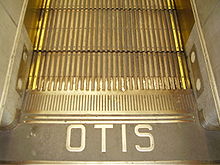 Wooden treads on a 1930s Otis escalator at Wynyard railway station, Sydney, Australia
Wooden treads on a 1930s Otis escalator at Wynyard railway station, Sydney, Australia
A few notable examples of historic escalators still in operation are:
Australia
- Town Hall Railway Station, Sydney, Australia
- Wynyard Railway Station, Sydney, Australia
Europe
- St. Anna Pedestrian Tunnel underneath the Schelde in Antwerp, Belgium. This tunnel was opened in 1933.
- Tyne Cyclist and Pedestrian Tunnel, Tyne and Wear, England
- -These escalators, manufactured by Waygood Otis in 1951, were "believed to be the longest single lift escalators in the world", at the time of installation. Presumably the first escalators in Britain designed specifically for cyclists, they are also "thought to be still" the longest escalators in the United Kingdom. At most, they may be the longest extant wooden escalators in operation in the world.[50]
- Greenford Station in Greenford, England contains the oldest escalator still in use on the London Underground service. This was the first above ground station to install an escalator to its high levels and one of the only (if not the only) wooden escalators not to be replaced after the fire at Kings Cross station.
North America
- Macy's Herald Square department store, Otis L-type units with wood treads and replacement metal treads, New York, New York
- Kaufmann's department store (now Macy's), two 16-inch (400 mm) Otis L-type units with original floorplates, several 40-inch (1000 mm) Otis escalators ca. 1950s, Pittsburgh, Pennsylvania
- Westfield San Francisco Centre (formerly The Emporium), chrome-and-glass escalator by Eleanor LeMaire for Otis, San Francisco, California
Escalators: superlatives
Longest systems
- Central-Mid-Levels escalator: in Hong Kong, tens of thousands of commuters travel each work day between Central, the central business district, and the Mid-levels, a residential district hundreds of feet uphill, using this long distance system of escalators and moving walkways. It is the world's longest outdoor escalator system (not a single escalator span), at a total length of 2,600 feet (790 m). It goes only one way at a time; the direction reverses depending on rush hour traffic direction.
- Ocean Park, Hong Kong: a long escalator system connecting two parts of the Park, with an overall length of 730 feet (220 m).
Longest individual escalators
Asia and Europe
Several "metro" or "subway" systems in Central and Eastern Europe feature very long escalators.
- In the Park Pobedy station of the Moscow Metro, opened in 2003, the escalators are 126.8 m (63.4 m high), or 740 steps, long, and take nearly three minutes to transit. Deep underground stations in St. Petersburg have escalators up to approximately 142 m long (71 m high).
- The Kiev Metro Kreschatik station's lower-level second exit escalator (a type ЛТ-2, circa 1965), lifts riders 216 feet (66 m), or 743 steps, up a 432-foot (132 m)-long incline.[citation needed]
- The longest escalator in Prague is at the Náměstí Míru station at 290 feet (88 m).
- The longest escalator of a European shopping mall is at MyZeil, Frankfurt, Germany, with a length of 150 feet (46 m).
- The tallest escalator on the London Underground system is at Angel station with a length of 197 feet (60 m), and a vertical rise of 90 feet (27 m).
- The longest wooden escalators in the United Kingdom are at the Tyne Tunnel, with a length of 200 feet (61 m). (See above.)
- The longest escalator on the Stockholm Metro, and in Western Europe, is at Västra skogen with a length of 220 feet (67 m) and in Helsinki Metro at Kamppi station with a length of 210 feet (64 m).
- The largest "single truss escalator" is in the Bentall Centre in Kingston upon Thames in Greater London, UK. It connects the ground floor with the second floor with only top and bottom supports.[citation needed]
- The longest escalator in Bangkok, Thailand and Southeast Asia is in Bangkok Metro's Si Lom Station. It connect concourse level with platform 1 which heading to Hua Lam Phong. It is 43 m. in length and about 20 m. in depth.
North and South America
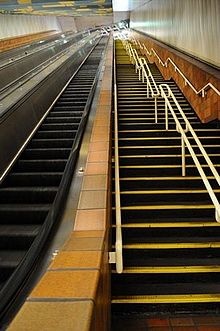 View from bottom of Porter Square escalator, 2010
View from bottom of Porter Square escalator, 2010
- The longest set of single-span uninterrupted escalators in the Western Hemisphere is at the Wheaton station of the Washington Metro system. They are 230 feet (70 m)[51][52] long with a vertical rise of 115 feet (35 m),[citation needed] and take what is variously described as 2 minutes and 45 seconds[citation needed] or nearly three-and-a-half minutes,[53] to ascend or descend without walking.
- The longest freestanding (supported only at the ends) escalator in the world is inside CNN Center’s atrium in Atlanta, Georgia. It rises 8 stories and is 205 feet (62 m) long. Originally built as the entrance to the amusement park The World of Sid and Marty Krofft, the escalator is now used for CNN studio tours.[54]
Shortest examples
Asia
According to Guinness, the shortest escalator in the world is in the Okadaya Mores shopping mall in Kawasaki, Japan. Its vertical rise is only 32.8 inches (83 cm).
Video: http://www.youtube.com/watch?v=FSLwCImWv-c
North America
The shortest escalator in the United States is a Schindler unit at the entrance to the JCPenney Department Store in Westfield Garden State Plaza in Paramus, New Jersey.[citation needed]
Notable spiral escalator installations
Asia
- Wheelock Place, Singapore
- Jeddah Hilton, Saudi Arabia
- Landmark Tower, Japan
- Times Square shopping mall, Causeway Bay, Hong Kong
- Lotte World, South Korea
- The Venetian hotel and casino, Cotai, Macau
- WTC Mangga Dua, Jakarta, Indonesia (the only one in Indonesia)
- Taipei, Taiwan
North America
- Wynn Las Vegas, Las Vegas, Nevada, United States
- The Forum Shops at Caesars, Las Vegas, Nevada, United States
- Westfield San Francisco Centre, San Francisco, California, United States—the first such installation in the Western Hemisphere.[55]
- River Rock Casino Resort, Richmond, British Columbia, Canada-the first in Canada.
- Bloomberg Corporation Office, New York City, New York.
Etiquette
On some busy systems, such as those in the UK, US, China and Japan, there is a policy of standing on the right. This way, the left-hand side of the escalators is left for those walking and overtaking.[56][57][58][59]
See also
- Central-Mid-Levels escalator (Hong Kong)
- Moving walkway
- People mover
- Cartveyor Shopping Cart Escalator
- Elevator
- Funicular
- Stairlift
References and notes
- ^ Strakosch, George R. Vertical Transportation, Elevators and Escalators, New York: John Wiley & Sons, 1983.
- ^ [Special devices in India http://www.delhimetrorail.com/commuters/passenger_safety.html]
- ^ Snow, Kate (October 5, 2006). Crocs can pose a danger on escalators ABC News.. Retrieved 2007-04-19.
- ^ AP (April 21, 2008). Kids Hurt While Wearing Crocs on Escalators. ABC Business News. Retrieved 2009-11-05.
- ^ Experts recommend caution while wearing clogs WMC-TV Memphis Tennessee. September 21, 2006. Retrieved 2007-04-19.
- ^ "Вечерняя Москва - главные новости дня". Vmdaily.ru. http://www.vmdaily.ru/article.php?aid=10055. Retrieved 2011-11-16.
- ^ "http://ncdrc.nic.in/OP812001.html". Ncdrc.nic.in. http://ncdrc.nic.in/OP812001.html. Retrieved 2011-11-16.
- ^ Geier, Peter (2005). "Escalator fatality leads to $5M lawsuit". The Daily Record (Baltimore). http://findarticles.com/p/articles/mi_qn4183/is_20050329/ai_n13478539/pg_1.
- ^ By Thomas Harding / MLB.com (2011-01-01). "Fans hurt in escalator accident | ColoradoRockies.com: News". Colorado.rockies.mlb.com. http://colorado.rockies.mlb.com/news/article.jsp?ymd=20030703&content_id=407033&vkey=news_col&fext=.jsp&c_id=col. Retrieved 2011-11-16.
- ^ POSTED: 11:04 am MDT May 19, 2005 (2005-05-19). "Woman Who Lost Leg In Escalator Mishap Sues Rockies - Denver News Story - KMGH Denver". Thedenverchannel.com. http://www.thedenverchannel.com/news/4508074/detail.html. Retrieved 2011-11-16.
- ^ "工程資訊". Twce.org.tw. http://www.twce.org.tw/info/%E6%8A%80%E5%B8%AB%E5%A0%B1/431-4-2.htm. Retrieved 2011-11-16.
- ^ Daniel, Mac. "Man is Strangled After Clothing Snags in MBTA Escalator." The Boston Globe, Wednesday, March 2, 2005, available: http://www.boston.com/news/local/articles/2005/03/02/man_is_strangled_after_clothing_snags_in_mbta_escalator/
- ^ "Rulletrappa i kjøpesenteret Sentrumsgården i Lyngdal hadde ikke påbudt fallsikring". Nrk.no. 2008-09-15. http://www.nrk.no/nyheter/distrikt/sorlandet/1.6221481. Retrieved 2011-11-16.
- ^ Ola Karlsson ola.karlsson@dt.se. "Joakim kunde inte räddas" (in (Swedish)). Dt.se. http://www.dt.se/nyheter/falun/article422379.ece. Retrieved 2011-11-16.
- ^ Foto: Lars-Olof Strömberg (2009-06-26). "Föll mot döden från rulltrappa". Kvp.se. http://www.kvp.se/nyheter/1.1620536/foll-mot-doden-fran-rulltrappa. Retrieved 2011-11-16.
- ^ Moore, Malcolm. "Teenager dead in Beijing escalator accident". Telegraph. http://www.telegraph.co.uk/news/worldnews/asia/china/8618495/Teenager-dead-in-Beijing-escalator-accident.html. Retrieved 2011-11-16.
- ^ Moodie, K. “The King’s Cross Fire: Damage Assessment and Overview of the Technical Investigation.” ‘’Fire Safety Journal’’, Vol. 18, 1992: 13–33.
- ^ ”Sam Webb Considers the Conclusions of the Fennell Report,” ‘’Building Design’’, Nov. 19, 1988: 2.
- ^ ”Building Design Editorial: the King’s Cross Inquiry,” ‘’Building Design’’, Nov. 19, 1988: 9
- ^ ”Negligence: Escalator Not an Attractive Nuisance,” Michigan Law Review, Vol. 38, No. 2 (Dec. 1939): 265 – 267.
- ^ ”ADA Requirements, November 23, 1998,” U.S. Department of Justice, Civil Rights Division, 1998: 3.
- ^ Elevator Escalator Safety Foundation, "How to Ride Safely on Elevators, Escalators, and Moving Walks," 2007.
- ^ Ames, N. "Revolving Stairs," U. S. Patent 25076. Aug. 9, 1859. Available: http://uspto.gov
- ^ Souder, Leamon. "Stairway," U. S. Patent 406314. July 2, 1889. Available: http://uspto.gov
- ^ Reno, Jesse W. "Endless Conveyer or Elevator," U. S. Patent 47091815. March 1892. Available: http://uspto.gov
- ^ Wheeler, G. A., "Elevator," U. S. Patent 479864, Aug. 2, 1892. Available: http://uspto.gov.
- ^ On record and in practice, this is accepted as the world's first operable escalator installation. Dates for the Harrods Piat escalator installation are inconsistent.
- ^ Topel, Michael. "Ancient Escalator Was a Link to History", The Patriot-Ledger, Apr. 3, 1995. See also King, John. "A Matter of Perception: Escalators, Moving Walks, and the Motion of Society", in Up Down Across: Elevators, Escalators and Moving Sidewalks. (Alisa Goetz, ed.) London: Merrell, 2003: 79–89.
- ^ Lancaster, Bill. The Department Store: a Social History. London: Leicester University Press, 1995: 50.
- ^ "The First Moving Staircase in England," The Drapers' Record, Nov. 19, 1898: 465.
- ^ Dorsch, Jeff. "Schindler Holding Ltd.," Hoover’s Business Database, http://www.hoovers.com, Mar. 2007.
- ^ LTM collection London's Transport Museum Photographic Collection, "1906 Escalator Operated on Opening Day of Great Northern Picadilly and Brompton Railway, December 15, 1906."
- ^ Hillinger, Charles. "Spiral Escalator May Be his Wheel of Fortune", Los Angeles Times, Nov. 11, 1973: 3.
- ^ "Elevators & Escalators - MITSUBISHI ELECTRIC". Mitsubishi-elevator.com. http://www.mitsubishi-elevator.com/innovations/spiral_escalators.html. Retrieved 2011-11-16.
- ^ See: Barrow, Dennis. "Seeberg.doc", Internal document, Otis Elevator Co., Farmington, CT: United Technologies; "escalator, noun." OED Online. June 2004. Oxford University Press, available: http://dictionary.oed.com/cgi/entry/50077810; "Otis Firsts: Escalators in the Gaslight Era", Otis Elevator Co., available: <http://www.otis.com/otis150/section/1,2344,ARC3125_CLI1_RES1_SEC2,00.html>; "Subject: History of the Escalator" (unnumbered sales circular letter). Internal document, Otis Elevator Co., Farmington, CT: United Technologies, October 16, 1962; "The Word ‘Escalator’", Human Interest, Online. The Museum for the Preservation of Elevating History, available: http://www.theelevatormuseum.org/h/h-1.htm; Worthington, Jr., William. "Early Risers", American Heritage of Invention & Technology, Vol. 4, No. 3 (Winter 1989): 42; and Wosk, Julie. "Perspectives on the Escalator in Photography and Art", in Up Down Across: Elevators, Escalators and Moving Sidewalks. (Alisa Goetz, ed.) London: Merrell, 2003.
- ^ De Fazio, Diane H. Like Blood to the Veins: Escalators, their History, and the Making of the Modern World (Master's Thesis, Columbia University Graduate School of Architecture, Planning, and Preservation), 2007: 58 – 61.
- ^ De Fazio, 60. Seeberger noted that the public had come to call his invention the "escə‧lāʹ‧tər" (es-ca-LĀ-tor) by 1906.
- ^ a b Lewis, Charlton T. and Charles Short. A Latin Dictionary: Founded on Andrews’ Edition of Freund’s Latin Dictionary. Oxford: Clarendon Press, 1984.
- ^ Seeberger, Charles D. "Trade-mark for Passenger-Elevators." U. S. Trade-mark No. 34724. May 29, 1900. Available: http://uspto.gov
- ^ "escalate, verb." The Oxford English Dictionary. 2nd ed. 1989. OED Online. Oxford University Press Feb. 2007. <http://dictionary.oed.com/cgi/entry/50077808>.
- ^ "escalate, verb.²" The Oxford English Dictionary. 2nd ed. 1989. OED Online. Oxford University Press. Feb. 2007. <http://dictionary.oed.com/cgi/entry/50077808>.
- ^ Folsom, Ralph H. and Larry L. Teply. "Trademarked Generic Words", The Yale Law Journal, Vol. 89, No. 7 (Jun. 1980): 1323–1359.
- ^ Haughton Elevator Co. v. Seeberger85 U. S. P. Q. (BNA) 80–81 (Dec. Comm. Pat. 1950).
- ^ Gusrae, G. B. "Moving Sidewalks", Architectural Record, June 1956: 220.
- ^ London's Transport Museum Photographic Collection, same as reference #21 above. See also Orton, Ray. Moving People from Street to Platform: 100 Years Underground, Mobile, AL: Elevator World, Inc. 22-26, 2000.
- ^ "Lawrence will Add 25,000 to its Population within two Years", Boston Daily, Mar. 4, 1906: SM11.
- ^ Otis Elevator Company, Otis Escalators. New York: Otis Elevator Co., 1912: 9–10.
- ^ Logistics, Telstar. "Hunter's Point, Building 253, Shop floor escalator, 1948 | Flickr - Photo Sharing!". Flickr. http://www.flickr.com/photos/49502995517@N01/2266907. Retrieved 2011-11-16.
- ^ http://www.uss-hornet.org/ See also Goodwin, Jason. Otis: Giving Rise to the Modern City, Chicago: Ivan R. Dee, 2001.
- ^ "Tyne Tunnel: Construction History." Tyne Tunnel, Internet. http://www.tynetunnel.info/wps/wcm/connect/Tunnel/Pedestrian+and+Cycle+Tunnels/History/. Accessed: November 9, 2008.
- ^ Metro Facts. Washington Metropolitan Area Transit Authority. Accessed September 14, 2010.
- ^ The Washington Post. "Standing on the Left? You Must Be on Vacation", 5/17/2004, Washington, D.C.: http://www.washingtonpost.com/wp-dyn/articles/A31605-2004May16.html
- ^ Carroll, Caitlin. What's the deal with... the Wheaton Metro station escalator? The GW Hatchet. September 19, 2005.
- ^ www.cnn.com
- ^ Sachner, Paul M. "Two on the Town: Heritage on the Garden, in Boston, and San Francisco Centre, in San Francisco", Architectural Record, vol. 177, no. 6, May 1989: 122–127.
- ^ "Stand On The Right". Golondon.about.com. 2010-06-14. http://golondon.about.com/od/londontransport/qt/standonright.htm. Retrieved 2011-11-16.
- ^ Susan Thompson Last updated November 16 2011 3:39PM (2003-11-22). "The Times | UK News, World News and Opinion". Entertainment.timesonline.co.uk. http://entertainment.timesonline.co.uk/tol/arts_and_entertainment/film/london_film_festival/article6883065.ece. Retrieved 2011-11-16.
- ^ "Metro / Metro Etiquette, Washington D.C. - Local Customs". VirtualTourist. http://www.virtualtourist.com/travel/North_America/United_States_of_America/Washington_DC/Local_Customs-Washington_DC-Metro_Metro_Etiquette-BR-1.html. Retrieved 2011-11-16.
- ^ "Stand on the Right, Walk on the Left". Sinosplice. 2010-03-23. http://www.sinosplice.com/life/archives/2010/03/23/stand-on-the-right-walk-on-the-left. Retrieved 2011-11-16.
External links
- Worlds shortest escalator
- Escalator Footage from Union Station
- Moving Stairways/Escalators at www.theelevatormuseum.org
- The Elevator Escalator Safety Foundation
- Escalator troubles rooted in Metro's original design
- Why does it take so long to mend an escalator?, London Review of Books
- A "self starting" escalator. Escalators may consume energy and incur extra "wear and tear", both of which add to the operating costs. This may be ameliorated by use of a "self-starting" escalator. This feature can be seen in action in this 13-second handheld video clip named 'Essen-self-starting-escalator320.mpg'.
- A videoclip: escalators with transparent sides showing the mechanism in operation.
- Escalator safety hazard alerts.
- Child safety and prams on escalators.
Rooms, spaces, and architectural elements Public areas - Airport lounge
- Auditorium
- Cafeteria
- Classroom
- Changing room / Locker room
- Conference hall
- Doctor's office
- Function hall
- Mailroom
- Library
- Lobby
- Office
- Refectory
- Restroom
- Security
- Waiting room
Passages and spaces Utility and storage - Attic
- Basement
- Box room / Carport
- Cloakroom
- Closet
- Electrical room
- Equipment room
- Furnace room / Boiler room
- Garage
- Janitorial closet
- Laundry room / Utility room
- Mechanical room / floor
- Pantry
- Root cellar
- Semi-basement
- Studio
- Server room
- Wardrobe
- Workshop
- Vault
- Wine cellar
- Wiring closet / Demarcation point
Shared residential rooms Private rooms Great house areas - Ballroom
- Butler's pantry
- Buttery
- Drawing room
- Fainting room
- Great chamber
- Great hall
- Larder
- Long gallery
- Lumber room
- Parlour
- Root cellar
- Salon
- Saucery
- Scullery
- Servants' hall
- Servants' quarters
- Smoking room
- Solar
- Spicery
- Stillroom
- Undercroft
Other areas Architectural elements Related terms - Building
- Furniture
- House
- House plan
- Rooms
Categories:- Vertical transport devices
- Stairways
- Pedestrian infrastructure
- American inventions
- 1900 introductions
Wikimedia Foundation. 2010.



